The lead curator of the 'Creative Encounters' program hopes it will give the public a chance to 'pull back the curtain' on spiritual practices.
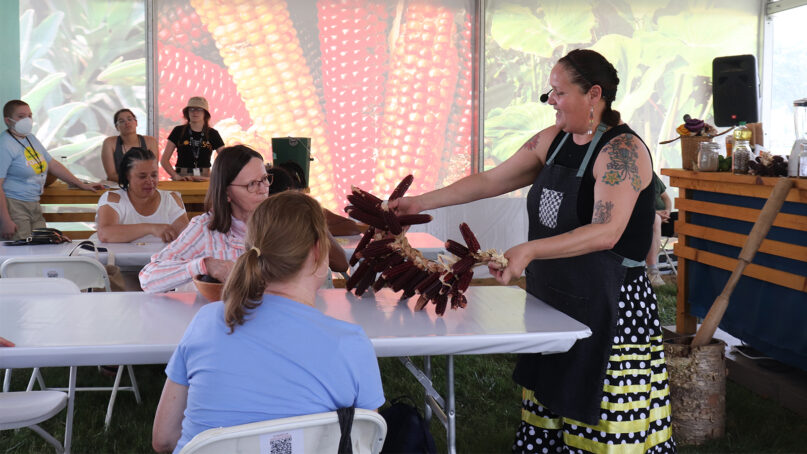
Elena Terry, right, leads a "Corn Futures" workshop in the Kitchen Theology tent during the annual Smithsonian Folklife Festival, Thursday, June 29, 2023, on the National Mall in Washington.
RNS photo by Adelle M. Banks
June 30, 2023
By Adelle M. Banks
WASHINGTON (RNS) — In one corner of an array of colorful booths and tents on a hazy day in the nation’s capital, Elena Terry prepared to “celebrate the beauty of corn” through ancestral-inspired dishes like corn crepes on the first day of the annual Smithsonian Folklife Festival.
“I want to be able to educate people about our life and our connection to food, the land, to each other and what that means as a Native woman in today’s world,” said the traditional Ho-Chunk woman from Wisconsin Dells, Wisconsin, in a Thursday (June 29) interview at the “Kitchen Theology” tent on the National Mall.
“I would like them to understand that we are still here, we do still live our religion daily and that it isn’t something that is structured anything like this other idea of what religion might be in that we are just spiritual people.”
Terry, the founder and executive chef of Wild Bearies, a nonprofit catering and community outreach organization, is one of dozens of participants featured in the festival’s program, titled “Creative Encounters: Living Religions in the U.S.” Steps away from her tent were booths about a Hindu temple in Illinois, Arabic calligraphy by a D.C. artist, and images of “santos,” or saints, from a New Mexico carver.
Michelle Banks, lead curator of the “Creative Encounters” program, said organizers hope it will give members of the public a chance to “pull back the curtain” on spiritual practices they know little about but that may be embraced by their neighbors.
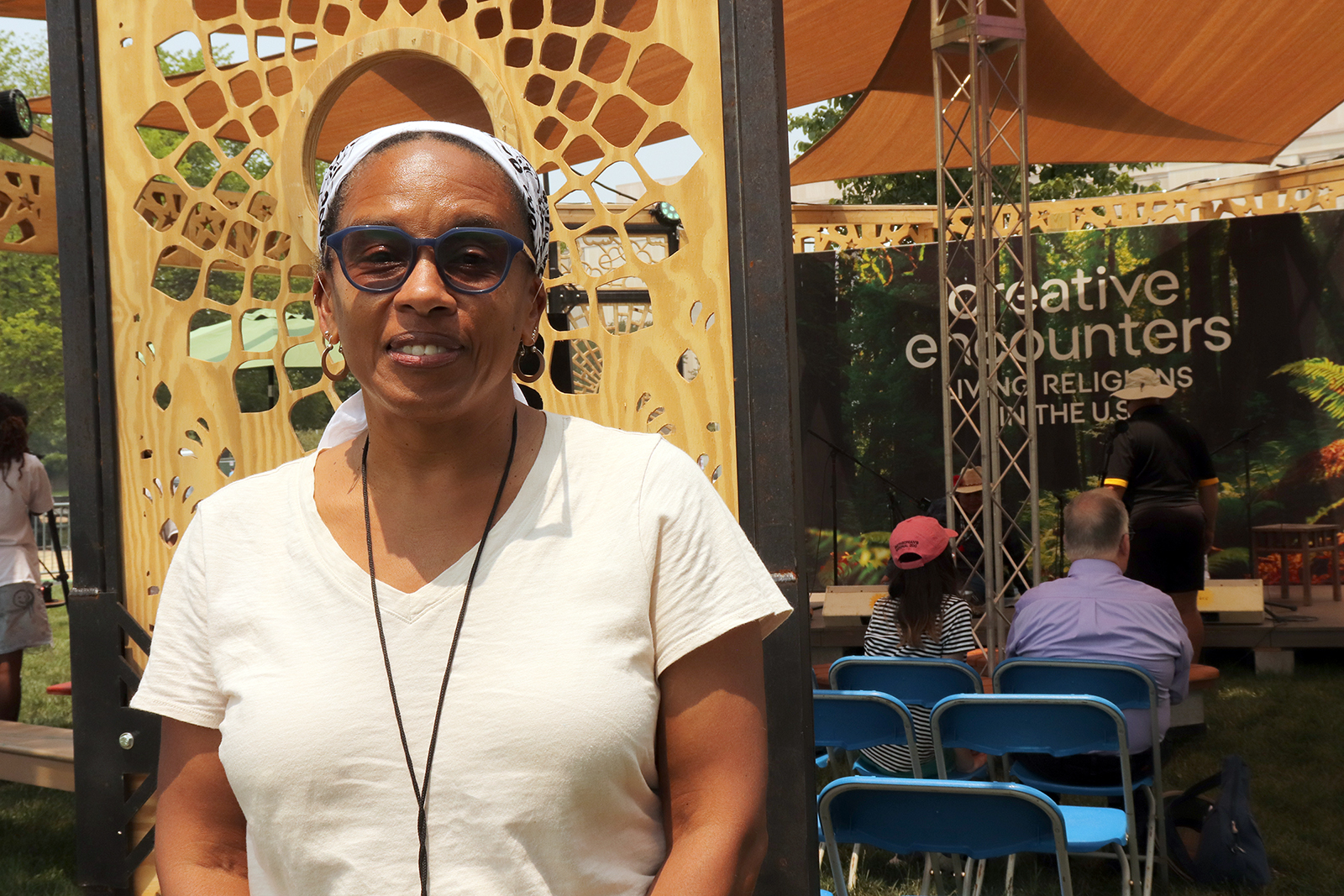
Michelle Banks is lead curator of the “Creative Encounters” program of the Smithsonian Folklife Festival on the National Mall in Washington. RNS photo by Adelle M. Banks
“One of the things we asked ourselves when we first started looking at this was: How often do people from any religious or spiritual community or tradition visit another place of worship?” she said in an interview in the Creative Encounters’ area across the street from the National Museum of American History.
RELATED: Finding spirituality on Earth’s ‘most secular’ continent
“We’re hoping to start a conversation,” she added, expecting some may use the festival as a way to “ask this question that I’ve been curious about but haven’t quite been sure how to ask about in the past.”
The program focuses on key ways faith practices are expressed, from “body and spirit,” including gestures and dance, to “sound religion,” including music, stories and mantras.
As she sat for an interview, a bell rang intermittently from a nearby booth of the Hindu Temple of Greater Chicago.
Bhanoo Sharma, president of the temple in Lemont, Illinois, later explained that the sound accompanies prayer for priests and devotees alike.
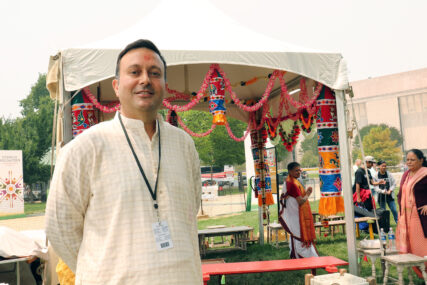
Bhanoo Sharma at the annual Smithsonian Folklife Festival, titled “Creative Encounters: Living Religions in the U.S.”, Thursday, June 29, 2023, on the National Mall in Washington. RNS photo by Adelle M. Banks
A Hindu booth at the Smithsonian Folklife Festival, Thursday, June 29, 2023, on the National Mall in Washington. RNS photo by Adelle M. Banks
“When we’re praying, it’s kind of like we’re awakening ourselves,” he said. “The bell is almost a rhythmic chant while we’re singing. It helps, in a way, keep time as well. It’s also almost as if we are feeling like we are awakening God to listen to our prayer, symbolically.”
In the first couple of hours of the festival, Sharma said he was learning about the other traditions demonstrated nearby and found connections with lessons being taught by a New Mexico artisan who made carvings of saints using the wood available in his state.
“It’s very similar to the way our artisans carve our deities in India out of marble, and it’s just whatever material is available,” he said. “It’s kind of neat that everybody uses what’s convenient and what’s around them.”
Nicolás Otero, an Albuquerque teacher and artist, said he views the materials of his artwork as a divine gift.
“The earth is provided for us, so the paints come from the earth; the wood that we carve comes from the earth, given to us from a greater power, the creator,” said Otero, whose roots are Indigenous, Hispanic and Catholic. “That’s how I see and believe — how I’m able to do what I do.”
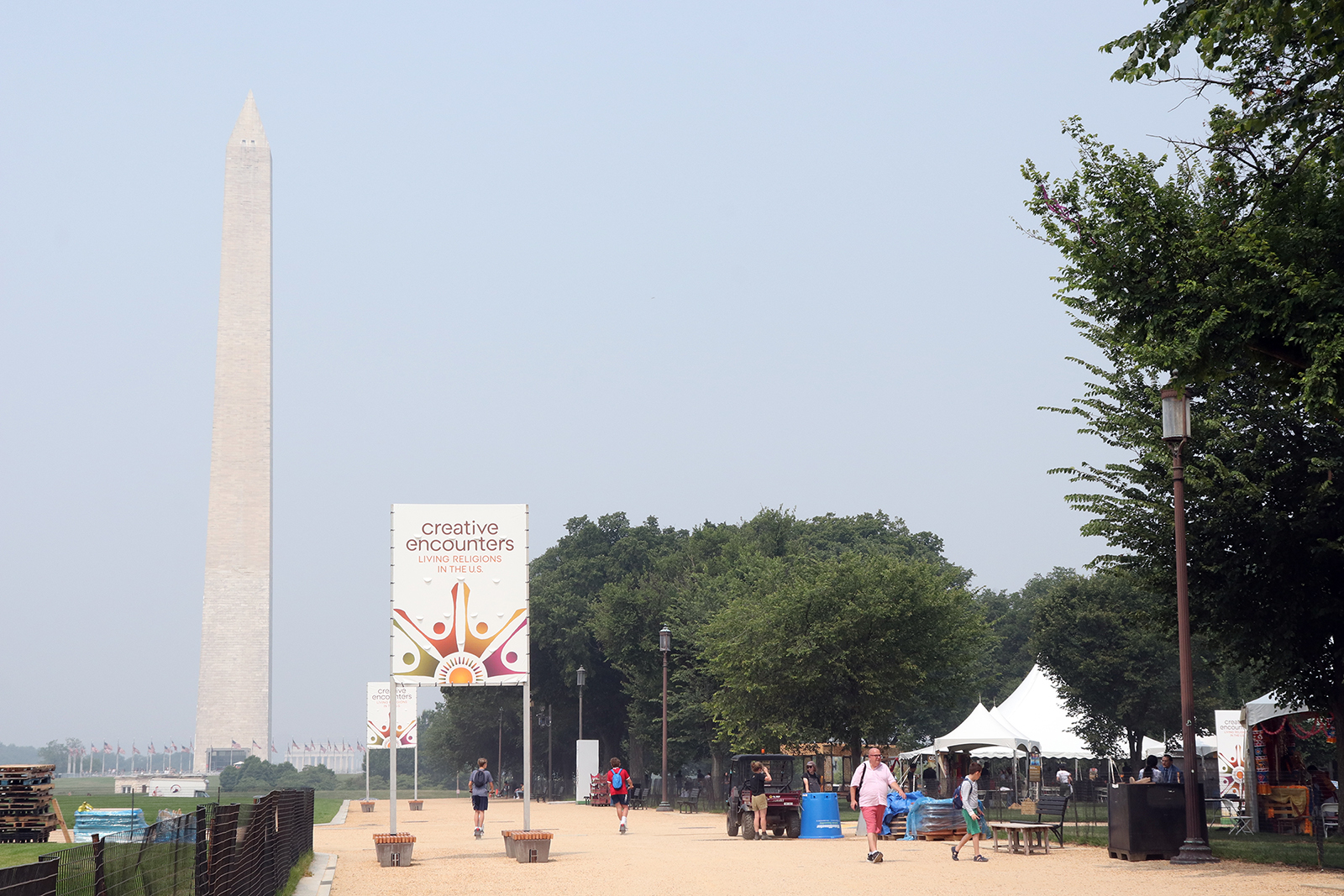
“Creative Encounters: Living Religions in the U.S.” at the Smithsonian Folklife Festival, Thursday, June 29, 2023, on the National Mall in Washington. RNS photo by Adelle M. Banks
Bob and Ann Wicks, of Oxford, Ohio, said the exhibits helped them gain better understanding of traditions practiced around the country through conversations and interactions with the presenters.
“For me the most important thing is that these are traditions that are infused with meaning and have religious significance — more spiritual significance — within the community. That really helps provide a sense of unity,” he said.
His wife said they visited a table where they were told to “think of your ancestors” as they helped make flowers out of colorful tissue paper for the “ofrendas,” or offerings, for the Indigenous holiday Dia de los Muertos, Day of the Dead.
“There’s a lot of things that we had no idea that — on the surface, oh it’s just a flower and it’s just an arch — but actually it’s a lot more,” he said.

Alec Esparza, right, creates flowers with Smithsonian volunteer Seona Jung, left, and Smithsonian intern Paloma Sanchez on the National Mall. RNS photo by Adelle M. Banks
Alec Esparza, one of the East Los Angeles artists with Mexican roots, was creating the flowers with a Smithsonian intern and volunteer.
“It’s a celebration of life, not how they passed away or died,” he said of the recollection of ancestors. “So what we remember is how they lived, and we do that so that we never forget who they are and how they lived.”
As he spoke, to his left, shaped-note singers sang the tune often used with the song “Just a Little Talk with Jesus,” and to his right, a group demonstrating the work of the Threshold Singers, a hospice music ministry, encircled a woman stretched out before them as they sang gentle music.
“When we’re praying, it’s kind of like we’re awakening ourselves,” he said. “The bell is almost a rhythmic chant while we’re singing. It helps, in a way, keep time as well. It’s also almost as if we are feeling like we are awakening God to listen to our prayer, symbolically.”
In the first couple of hours of the festival, Sharma said he was learning about the other traditions demonstrated nearby and found connections with lessons being taught by a New Mexico artisan who made carvings of saints using the wood available in his state.
“It’s very similar to the way our artisans carve our deities in India out of marble, and it’s just whatever material is available,” he said. “It’s kind of neat that everybody uses what’s convenient and what’s around them.”
Nicolás Otero, an Albuquerque teacher and artist, said he views the materials of his artwork as a divine gift.
“The earth is provided for us, so the paints come from the earth; the wood that we carve comes from the earth, given to us from a greater power, the creator,” said Otero, whose roots are Indigenous, Hispanic and Catholic. “That’s how I see and believe — how I’m able to do what I do.”

“Creative Encounters: Living Religions in the U.S.” at the Smithsonian Folklife Festival, Thursday, June 29, 2023, on the National Mall in Washington. RNS photo by Adelle M. Banks
Bob and Ann Wicks, of Oxford, Ohio, said the exhibits helped them gain better understanding of traditions practiced around the country through conversations and interactions with the presenters.
“For me the most important thing is that these are traditions that are infused with meaning and have religious significance — more spiritual significance — within the community. That really helps provide a sense of unity,” he said.
His wife said they visited a table where they were told to “think of your ancestors” as they helped make flowers out of colorful tissue paper for the “ofrendas,” or offerings, for the Indigenous holiday Dia de los Muertos, Day of the Dead.
“There’s a lot of things that we had no idea that — on the surface, oh it’s just a flower and it’s just an arch — but actually it’s a lot more,” he said.

Alec Esparza, right, creates flowers with Smithsonian volunteer Seona Jung, left, and Smithsonian intern Paloma Sanchez on the National Mall. RNS photo by Adelle M. Banks
Alec Esparza, one of the East Los Angeles artists with Mexican roots, was creating the flowers with a Smithsonian intern and volunteer.
“It’s a celebration of life, not how they passed away or died,” he said of the recollection of ancestors. “So what we remember is how they lived, and we do that so that we never forget who they are and how they lived.”
As he spoke, to his left, shaped-note singers sang the tune often used with the song “Just a Little Talk with Jesus,” and to his right, a group demonstrating the work of the Threshold Singers, a hospice music ministry, encircled a woman stretched out before them as they sang gentle music.
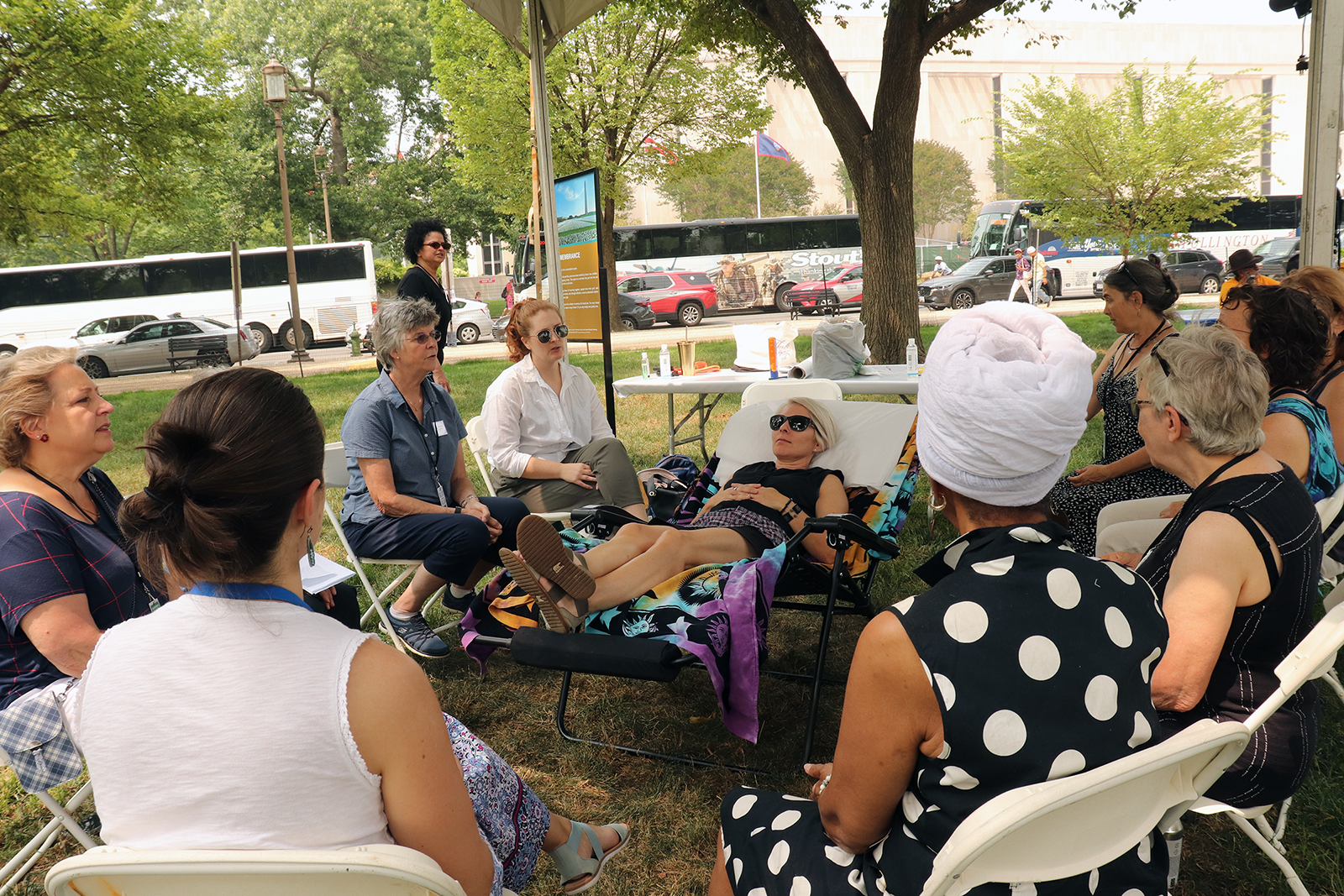
The Threshold Singers, a hospice music ministry, demonstrate their singing around a lounging individual, Thursday, June 29, 2023, on the National Mall in Washington. RNS photo by Adelle M. Banks
Arabic calligrapher Josh Berer describes himself as nonreligious but said his work immerses him in the sermons and other messages of the Muslim faith.
“Islamic calligraphy and the religion Islam are intrinsically and forever linked — without one there cannot be the other,” he said.
He pointed to a colorful illustration on display behind him as an example, featuring words from a sermon from Ali Ibn Abi Talib, an early leader of Shia Muslims and a relative of the Prophet Muhammad.
“It’s ultimately just life advice — how to be a good person in the world,” Berer said, noting that one part of the framed art can be translated to say: “One who rejects worldliness is not affected by poverty.”
He said being able to talk to passersby at the festival helped reinforce that this work of “sacred art” is a modern-day practice and not solely relegated to the status of a museum artifact: “It’s something that people aren’t really aware exists anymore.”
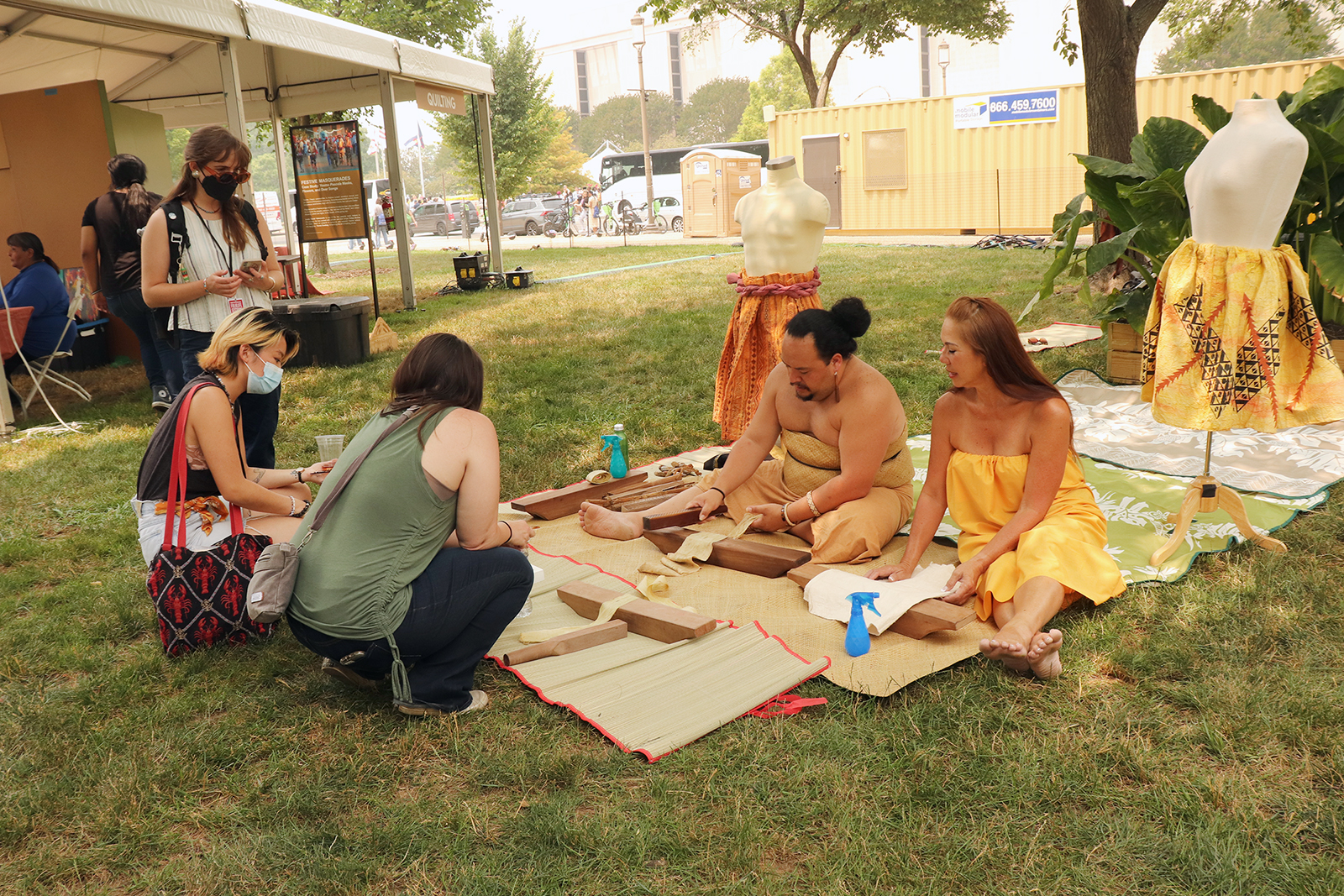
Hawaiians Kumu Micah Kamohoalii, center, and Arleen Wright-Kauahi, right, explain using bark to make clothing during the Smithsonian Folklife Festival, Thursday, June 29, 2023, on the National Mall in Washington. RNS photo by Adelle M. Banks
The festival, which returned to an in-person event on the Mall last year after going virtual in 2021, had to cancel its opening ceremony because of unhealthy air quality in the D.C. area — due to smoke drifting from wildfires in Canada.
Banks said some participants stayed away due to the conditions. She hoped for more robust participation during the rest of the festival, which is held through July 4 and again July 6-9.
RELATED: PHOTO GALLERY: The history and diversity of African American religious rituals
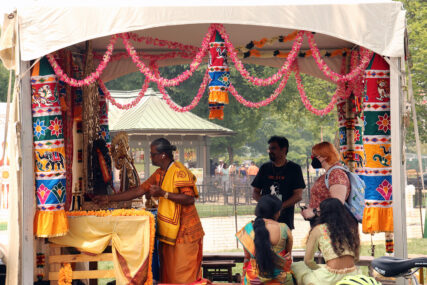
No comments:
Post a Comment